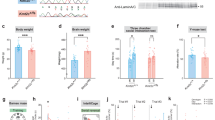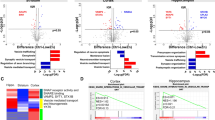Abstract
Autism spectrum disorders (ASD) are highly heterogeneous neurodevelopmental disorders characterized by impaired social interaction skills. Whole exome sequencing has identified loss-of-function mutations in lysine methyltransferase 2E (KMT2E, also named MLL5) in ASD patients and it is listed as an ASD high-risk gene in humans. However, experimental evidence of KMT2E in association with ASD-like manifestations or neuronal function is still missing. Relying on KMT2E+/− mice, through animal behavior analyses, positron emission tomography (PET) imaging, and neuronal morphological analyses, we explored the role of KMT2E haploinsufficiency in ASD-like symptoms. Behavioral results revealed that KMT2E haploinsufficiency was sufficient to produce social deficit, accompanied by anxiety in mice. Whole-brain 18F-FDG-PET analysis identified that relative amygdala glycometabolism was selectively decreased in KMT2E+/− mice compared to wild-type mice. The numbers and soma sizes of amygdala neurons in KMT2E+/− mice were prominently increased. Additionally, KMT2E mRNA levels in human amygdala were significantly decreased after birth during brain development. Our findings support a causative role of KMT2E in ASD development and suggest that amygdala neuronal development abnormality is likely a major underlying mechanism.








Similar content being viewed by others
Data Availability
All data generated, collected, and analyzed here are available from the corresponding author upon reasonable request.
References
Lord C, Brugha TS, Charman T, Cusack J, Dumas G, Frazier T, Jones EJH, Jones RM et al (2020) Autism spectrum disorder. Nat Rev Dis Primers 6(1). https://doi.org/10.1038/s41572-019-0138-4
Keller F, Persico AM (2003) The neurobiological context of autism. Mol Neurobiol 28(1):1–22. https://doi.org/10.1385/MN:28:1:1
Zhao H, Mao X, Zhu C, Zou X, Peng F, Yang W, Li B, Li G et al (2021) gabaergic system dysfunction in autism spectrum disorders. Front Cell Dev Biol 9:781327. https://doi.org/10.3389/fcell.2021.781327
Li Z, Jagadapillai R, Gozal E, Barnes G (2019) Deletion of semaphorin 3F in interneurons is associated with decreased GABAergic neurons, autism-like behavior, and increased oxidative stress cascades. Mol Neurobiol 56(8):5520–5538. https://doi.org/10.1007/s12035-018-1450-9
Iossifov I, O Roak BJ, Sanders SJ, Ronemus M, Krumm N, Levy D, Stessman HA, Witherspoon KT et al (2014) The contribution of de novo coding mutations to autism spectrum disorder. Nature 515(7526):216–221. https://doi.org/10.1038/nature13908
Emerling BM, Bonifas J, Kratz CP, Donovan S, Taylor BR, Green ED, Le Beau MM, Shannon KM (2002) MLL5, a homolog of Drosophila trithorax located within a segment of chromosome band 7q22 implicated in myeloid leukemia. Oncogene 21(31):4849–4854. https://doi.org/10.1038/sj.onc.1205615
Zhang X, Novera W, Zhang Y, Deng LW (2017) MLL5 (KMT2E): structure, function, and clinical relevance. Cell Mol Life Sci 74(13):2333–2344. https://doi.org/10.1007/s00018-017-2470-8
Dong S, Walker MF, Carriero NJ, Dicola M, Willsey AJ, Ye AY, Waqar Z, Gonzalez LE et al (2014) De novo insertions and deletions of predominantly paternal origin are associated with autism spectrum disorder. Cell Rep 9(1):16–23. https://doi.org/10.1016/j.celrep.2014.08.068
Grove J, Ripke S, Als TD, Mattheisen M, Walters RK, Won H, Pallesen J, Agerbo E et al (2019) Identification of common genetic risk variants for autism spectrum disorder. Nat Genet 51(3):431–444. https://doi.org/10.1038/s41588-019-0344-8
Satterstrom FK, Kosmicki JA, Wang J, Breen MS, De Rubeis S, An JY, Peng M, Collins R et al (2020) Large-scale exome sequencing study implicates both developmental and functional changes in the neurobiology of autism. Cell 180(3):568–584. https://doi.org/10.1016/j.cell.2019.12.036
Herrero MJ, Velmeshev D, Hernandez-Pineda D, Sethi S, Sorrells S, Banerjee P, Sullivan C, Gupta AR et al (2020) Identification of amygdala-expressed genes associated with autism spectrum disorder. Mol Autism 11(1). https://doi.org/10.1186/s13229-020-00346-1
Krepischi-Santos AC, Vianna-Morgante AM, Jehee FS, Passos-Bueno MR, Knijnenburg J, Szuhai K, Sloos W, Mazzeu JF et al (2006) Whole-genome array-CGH screening in undiagnosed syndromic patients: old syndromes revisited and new alterations. Cytogenet Genome Res 115(3–4):254–261. https://doi.org/10.1159/000095922
Uliana V, Grosso S, Cioni M, Ariani F, Papa FT, Tamburello S, Rossi E, Katzaki E et al (2010) 3.2 Mb microdeletion in chromosome 7 bands q22.2–q22.3 associated with overgrowth and delayed bone age. Eur J Med Genet 53(3):168–170. https://doi.org/10.1016/j.ejmg.2010.02.003
Zhou P, Ding X, Wan X, Liu L, Yuan X, Zhang W, Hui X, Meng G et al (2018) MLL5 suppresses antiviral innate immune response by facilitating STUB1-mediated RIG-I degradation. Nat Commun 9(1):1243. https://doi.org/10.1038/s41467-018-03563-8
Cheh MA, Millonig JH, Roselli LM, Ming X, Jacobsen E, Kamdar S, Wagner GC (2006) En2 knockout mice display neurobehavioral and neurochemical alterations relevant to autism spectrum disorder. Brain Res 1116(1):166–176. https://doi.org/10.1016/j.brainres.2006.07.086
Kaidanovich-Beilin O, Lipina T, Vukobradovic I, Roder J, Woodgett JR (2011) Assessment of social interaction behaviors. J Visualized Exp (48). https://doi.org/10.3791/2473
Kim DG, Gonzales EL, Kim S, Kim Y, Adil KJ, Jeon SJ, Cho KS, Kwon KJ et al (2019) Social interaction test in home cage as a novel and ethological measure of social behavior in mice. Exp Neurobiol 28(2):247–260. https://doi.org/10.5607/en.2019.28.2.247
Rein B, Ma K, Yan Z (2020) A standardized social preference protocol for measuring social deficits in mouse models of autism. Nat Protoc 15(10):3464–3477. https://doi.org/10.1038/s41596-020-0382-9
Zhang Q, Hu DX, He F, Li CY, Qi GJ, Cai HW, Li TX, Ming J et al (2019) Locus coeruleus-CA1 projections are involved in chronic depressive stress-induced hippocampal vulnerability to transient global ischaemia. Nat Commun 10(1):2942. https://doi.org/10.1038/s41467-019-10795-9
Malhi GS, Mann JJ (2018) Depression. Lancet 392(10161):2299–2312. https://doi.org/10.1016/S0140-6736(18)31948-2
Gourley SL, Taylor JR (2009) Recapitulation and reversal of a persistent depression‐like syndrome in rodents. Curr Protoc Neurosci 49(1). https://doi.org/10.1002/0471142301.ns0932s49
Guan Z, Zhou X, Zhang X, Zhang Y, Wang Y, Guo Q, Ji G, Wu G et al (2016) Beclin-1- mediated autophagy may be involved in the elderly cognitive and affective disorders in streptozotocin-induced diabetic mice. Transl Neurodegener 5(1). https://doi.org/10.1186/s40035-016-0070-4
Pucilowska J, Vithayathil J, Tavares EJ, Kelly C, Karlo JC, Landreth GE (2015) The 16p11.2 deletion mouse model of autism exhibits altered cortical progenitor proliferation and brain cytoarchitecture linked to the ERK MAPK pathway. J Neurosci 35(7):3190–3200. https://doi.org/10.1523/JNEUROSCI.4864-13.2015
Xie XQ, Zhang P, Tian B, Chen XQ (2017) Downregulation of NAD-dependent deacetylase SIRT2 protects mouse brain against ischemic stroke. Mol Neurobiol 54(9):7251–7261. https://doi.org/10.1007/s12035-016-0173-z
Miller JA, Ding SL, Sunkin SM, Smith KA, Ng L, Szafer A, Ebbert A, Riley ZL et al (2014) Transcriptional landscape of the prenatal human brain. Nature 508(7495):199–206. https://doi.org/10.1038/nature13185
Yap DB, Walker DC, Prentice LM, Mckinney S, Turashvili G, Mooslehner-Allen K, de Algara TR, Fee J et al (2011) Mll5 is required for normal spermatogenesis. PLoS One 6(11):e27127. https://doi.org/10.1371/journal.pone.0027127
Qi G, Zhang P, Li T, Li M, Zhang Q, He F, Zhang L, Cai H et al (2022) NAc-VTA circuit underlies emotional stress-induced anxiety-like behavior in the three-chamber vicarious social defeat stress mouse model. Nat Commun 13(1):577. https://doi.org/10.1038/s41467-022-28190-2
First MB (2013) Diagnostic and statistical manual of mental disorders, 5th Edition, and Clinical Utility. J Nerv Ment Dis 201(9):727–729. https://doi.org/10.1097/NMD.0b013e3182a2168a
Qin L, Ma K, Wang Z, Hu Z, Matas E, Wei J, Yan Z (2018) Social deficits in Shank3-deficient mouse models of autism are rescued by histone deacetylase (HDAC) inhibition. Nat Neurosci 21(4):564–575. https://doi.org/10.1038/s41593-018-0110-8
Buchsbaum MS, Siegel BV, Wu JC, Hazlett E, Sicotte N, Haier R, Tanguay P, Asarnow R et al (1992) Brief report: Attention performance in autism and regional brain metabolic rate assessed by positron emission tomography. J Autism Dev Disord 22(1):115–125. https://doi.org/10.1007/BF01046407
Haznedar M (2006) Volumetric analysis and three-dimensional glucose metabolic mapping of the striatum and thalamus in patients with autism spectrum disorders. Am J Psychiat 163(7):1252. https://doi.org/10.1176/appi.ajp.163.7.1252
Rumsey JM, Duara R, Grady C, Rapoport JL, Margolin RA, Rapoport SI, Cutler NR (1985) Brain metabolism in autism: resting cerebral glucose utilization rates as measured with positron emission tomography. Arch Gen Psychiatry 42(5):448–455. https://doi.org/10.1001/archpsyc.1985.01790280026003
Amaral DG, Schumann CM, Nordahl CW (2008) Neuroanatomy of autism. Trends Neurosci 31(3):137–145. https://doi.org/10.1016/j.tins.2007.12.005
Telzer EH, Humphreys KL, Shapiro M, Tottenham N (2013) Amygdala sensitivity to race is not present in childhood but emerges over adolescence. J Cognitive Neurosci 25(2):234–244. https://doi.org/10.1162/jocn_a_00311
Davis M, Whalen PJ (2001) The amygdala: vigilance and emotion. Mol Psychiatr 6(1):13–34. https://doi.org/10.1038/sj.mp.4000812
Calhoon GG, Tye KM (2015) Resolving the neural circuits of anxiety. Nat Neurosci 18(10):1394–1404. https://doi.org/10.1038/nn.4101
Grupe DW, Nitschke JB (2013) Uncertainty and anticipation in anxiety: an integrated neurobiological and psychological perspective. Nat Rev Neurosci 14(7):488–501. https://doi.org/10.1038/nrn3524
Liao X, Liu Y, Fu X, Li Y (2020) Postmortem studies of neuroinflammation in autism spectrum disorder: a systematic review. Mol Neurobiol 57(8):3424–3438. https://doi.org/10.1007/s12035-020-01976-5
Zhao C, Dong C, Frah M, Deng Y, Marie C, Zhang F, Xu L, Ma Z et al (2018) Dual requirement of CHD8 for chromatin landscape establishment and histone methyltransferase recruitment to promote CNS myelination and repair. Dev Cell 45(6):753–768. https://doi.org/10.1016/j.devcel.2018.05.022
Fareri DS, Tottenham N (2016) Effects of early life stress on amygdala and striatal development. Dev Cogn Neuros-Neth 19:233–247. https://doi.org/10.1016/j.dcn.2016.04.005
Zhang X, Guan W, Yang T, Furlan A, Xiao X, Yu K, An X, Galbavy W et al (2021) Genetically identified amygdala-striatal circuits for valence-specific behaviors. Nat Neurosci 24(11):1586–1600. https://doi.org/10.1038/s41593-021-00927-0
Aggleton J (1992) The amygdala: neurobiological aspects of emotion, memory, and mental dysfunction, New York. John Wiley & Sons Inc
Schumann CM (2004) The amygdala is enlarged in children but not adolescents with autism; the hippocampus is enlarged at all ages. J Neurosci 24(28):6392–6401. https://doi.org/10.1523/JNEUROSCI.1297-04.2004
Mitra R, Sapolsky RM (2008) Acute corticosterone treatment is sufficient to induce anxiety and amygdaloid dendritic hypertrophy. Proc Natl Acad Sci U S A 105(14):5573–5578. https://doi.org/10.1073/pnas.0705615105
De Volder A, Bol A, Michel C, Congneau M, Goffinet AM (1987) Brain glucose metabolism in children with the autistic syndrome: positron tomography analysis. Brain Develop 9(6):581–587. https://doi.org/10.1016/S0387-7604(87)80089-X
Koe AS, Ashokan A, Mitra R (2016) Short environmental enrichment in adulthood reverses anxiety and basolateral amygdala hypertrophy induced by maternal separation. Transl Psychiat 6(2):e729. https://doi.org/10.1038/tp.2015.217
Tang G, Gutierrez Rios P, Kuo S, Akman HO, Rosoklija G, Tanji K, Dwork A, Schon EA et al (2013) Mitochondrial abnormalities in temporal lobe of autistic brain. Neurobiol Dis 54:349–361. https://doi.org/10.1016/j.nbd.2013.01.006
Varghese M, Keshav N, Jacot-Descombes S, Warda T, Wicinski B, Dickstein DL, Harony-Nicolas H, De Rubeis S et al (2017) Autism spectrum disorder: neuropathology and animal models. Acta Neuropathol 134(4):537–566. https://doi.org/10.1007/s00401-017-1736-4
Matovic S, Ichiyama A, Igarashi H, Salter EW, Sunstrum JK, Wang XF, Henry M, Kuebler ES et al (2020) Neuronal hypertrophy dampens neuronal intrinsic excitability and stress responsiveness during chronic stress. J Physiol 598(13):2757–2773. https://doi.org/10.1113/JP279666
Funding
This work was supported financially by grants from National Natural Science Foundation of China (No. 81972362 and 82173197 to X.Q.C; 81801760 to C.-Y.L), and the Fundamental Research Funds for the Central Universities (HUST: 2019kfyXJJS081 to P.Z.).
Author information
Authors and Affiliations
Contributions
Conceptualization, Y.-J.L., Q.L., and X.-Q.C.; methodology, Y.-J.L., C.L., C.-Y.L., D.-X.H., Q.L., X.L., and P.Z.; investigation, Y.-J.L., C.L., C.-Y.L., D.-X.H., Z.-B.X., and S.-H.Z.; manuscript writing, Y.-J.L., P.Z., and X.-Q.C.; funding acquisition, X.-Q.C.; resources, Q.L., X.L., P.Z., and X.-Q.C.; supervision, X.L., P.Z., and X.-Q.C.
Corresponding authors
Ethics declarations
Ethics Statement
Animal care, handling, and all experiments were performed according to the guidelines of the National Institutes of Health of the United States and approved by the ethics committee of Tongji Medical College of Huazhong University of Science and Technology.
Consent to Participate
Not applicable.
Consent for Publication
Not applicable.
Conflict of Interest
The authors declare no competing interests.
Additional information
Publisher's Note
Springer Nature remains neutral with regard to jurisdictional claims in published maps and institutional affiliations.
Supplementary Information
Below is the link to the electronic supplementary material.
Rights and permissions
Springer Nature or its licensor (e.g. a society or other partner) holds exclusive rights to this article under a publishing agreement with the author(s) or other rightsholder(s); author self-archiving of the accepted manuscript version of this article is solely governed by the terms of such publishing agreement and applicable law.
About this article
Cite this article
Li, YJ., Li, CY., Li, CY. et al. KMT2E Haploinsufficiency Manifests Autism-Like Behaviors and Amygdala Neuronal Development Dysfunction in Mice. Mol Neurobiol 60, 1609–1625 (2023). https://doi.org/10.1007/s12035-022-03167-w
Received:
Accepted:
Published:
Issue Date:
DOI: https://doi.org/10.1007/s12035-022-03167-w




